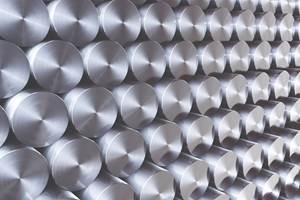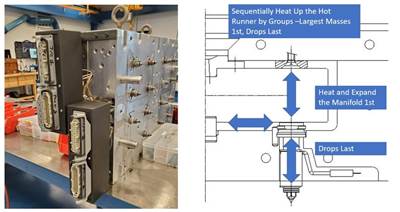
One solution to hot runner cable connection issues is 24-pin male and female connectors with a single-latch hood. Photos Credit, all images: Fast Heat by Spark Industries
Serious vulnerabilities exist when a mold builder or molder has problems with hot runner cable connections. However, there are solutions and ways to ensure you always use the right cables on the proper circuits. Here are the top five problems routinely experienced in the field.
1. Pushed-Back or Bent Pins
This image shows two pushed-back pins on the top of a mold in a 25-pin layout heater connector.
Note the 1-inch-long machined pin with a spring for press-fitting into the back of the male insert. These pins are delicate (1/16-inch-diameter exposed) and can easily be bent or pushed back when being mated to a female connector on a mold box, cable or hot runner controller.
Bent pins are likely to interfere with a connection and cause open circuits. Pushed-back pins are especially problematic when troubleshooting open circuits or other alarms because they can be intermittently connected. This can be seen on a hot runner controller as an open heater or thermocouple, and even thermocouple reverse or shorts.
2. Pushed-Back Inserts

Pushed-back pins or inserts.
This image shows the female insert base in a single latch hood. The metal inserts for each opening are press-fit into the base and can often be pushed back when inserting the mating and male connector.
Pushed-back pins or inserts are a common problem that can result in an intermittent current or an open circuit.
You can easily check to see if they are seated correctly by pressing a multimeter lead into the socket. If the insert is unseated, it will easily slide back and out of the socket.
3. High Amp Deterioration
The image above in problem two also shows burning and deterioration around some of the insulated holes. These types of connectors are only rated for 10 amps, yet many shops use them for manifold circuits that can easily exceed 15 amps.
It is highly recommended that molders ensure frequent preventative maintenance, increase amp ratings for larger heater applications or upgrade to a more robust connector system.
4. Loose or Broken Latches
Worn levers and latches allow a loose fit between cables and the adjoining hot runner controller or mold box. These loose connections cause intermittent currents and sometimes open circuits.
5. Missing or Loose Ground Wire Connections
Grounding from the hot half to the mold box through the cables and the controller and then to the facility ground is critically important. Unfortunately, ground connections are often loose, filthy dirty or missing entirely.
Solutions: A Better Connector
A quick fix includes 24-pin male and female connectors, which have a single-latch hood. Unlike the 25-pin connectors, these are heavy-duty. The pins won’t bend or get pushed back and are rated for 16 amps. They also have screw terminations for inserted wires and are much easier to connect to mating mold boxes, cables or controllers.
To ensure heater and thermocouple cables are clearly different, use dual-latch hoods for one and single-latch for the other, or use a combination heater and thermocouple cables with a single hood.
Related Content
Line Width vs. Depth Ratio in Laser Engraving
A laser does not produce 90-degree sidewalls. It requires a certain amount of draft in order to produce the required pattern.
Read MoreWhat You Should Consider When Purchasing Modified P20 Steel
When buying P20 steels that have been modified, moldmakers must be aware of the variations and key issues that affect delivery, cost and lead times.
Read MoreHow to Eliminate Chatter
Here are techniques commonly used to combat chatter and guidelines to establish a foundation for optimizing the moldmaking process.
Read MoreLaser Welding Versus Micro Welding
The latest battle in finely detailed restoration/repair of mold materials.
Read MoreRead Next
The Ins and Outs of Hot Runner Temperature Control
A training checklist that explains the why and how of proper hot runner temperature control and system management.
Read MoreReasons to Use Fiber Lasers for Mold Cleaning
Fiber lasers offer a simplicity, speed, control and portability, minimizing mold cleaning risks.
Read MoreAre You a Moldmaker Considering 3D Printing? Consider the 3D Printing Workshop at NPE2024
Presentations will cover 3D printing for mold tooling, material innovation, product development, bridge production and full-scale, high-volume additive manufacturing.
Read More


























